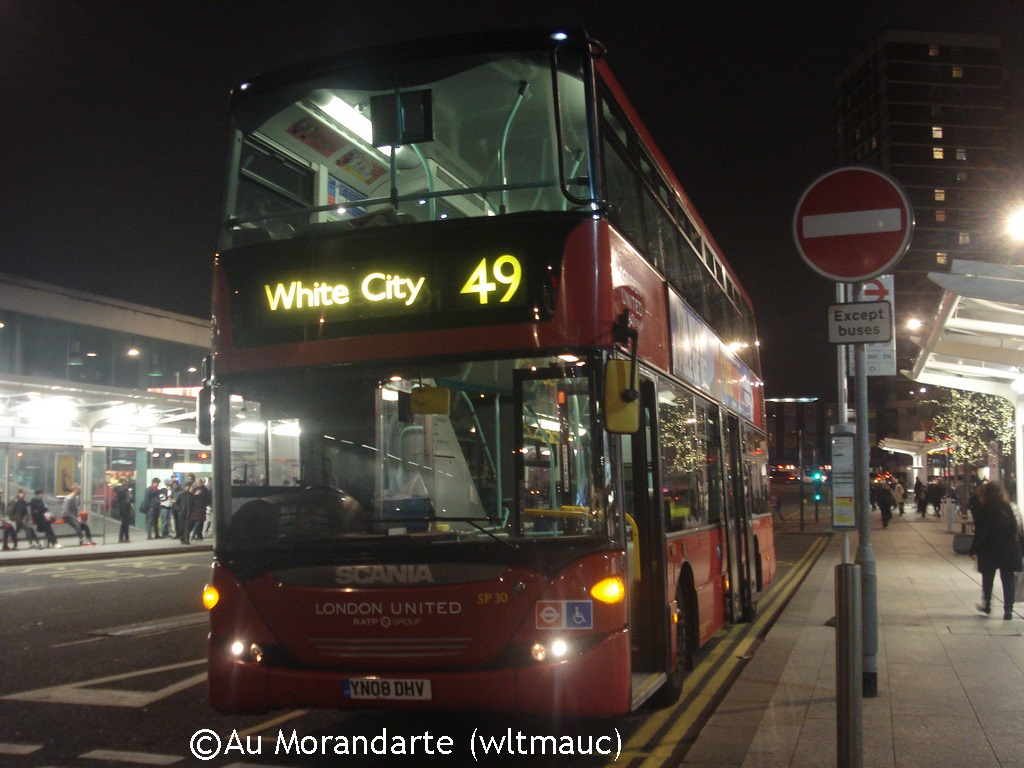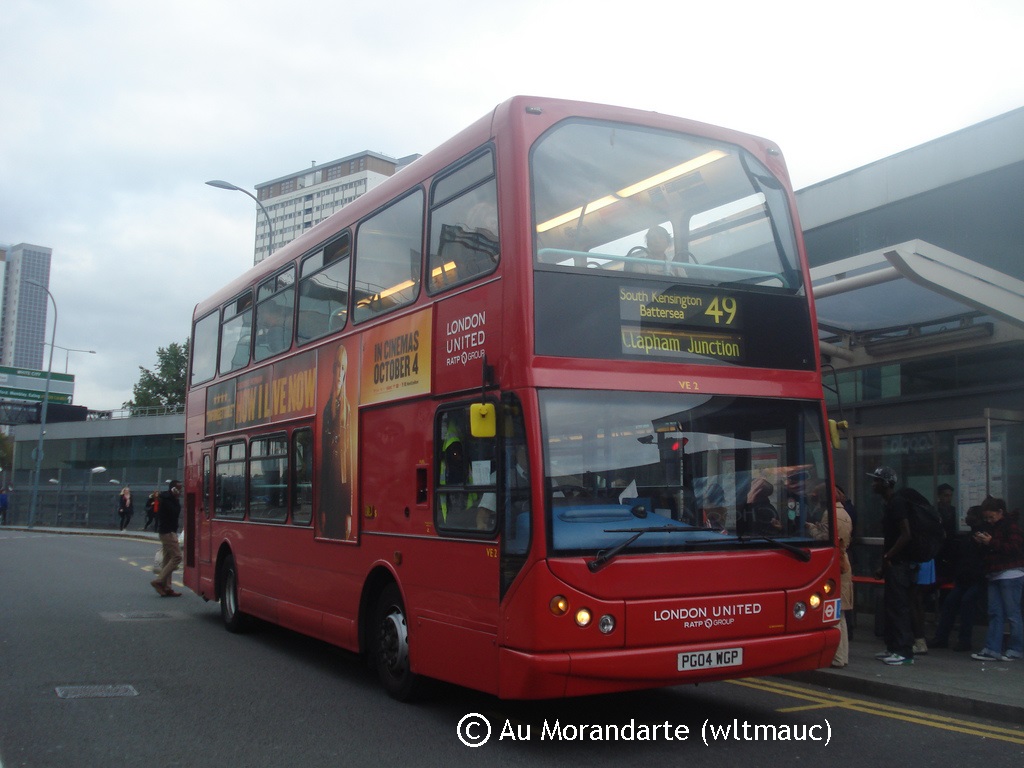 | Photo © Au Moran. |
Home | Bus routes | Operational details | Service changes | Operators & Garages | Photo gallery
One of the less successful fads of the late 1990s was the conversion of busy trunk routes to single deck operation with only modest frequency increases. Gradually these routes have reverted to double deck operation as the folly was realised. The last to be single decked, and one of the last to be double decked again, was the 49. Its single deck conversion in 1999 followed on from routes 319 and 345, to convert the entire Clapham Junction – Battersea – Chelsea corridor to single deck operation. Unlike the other two routes, London United thoughtfully specified extra long 10.7m Darts. But contract renewal in 2004 resulted in double deckers being restored, these being a mixture of older VA class buses cascaded from route 337, which had been lost, and new VE class vehicles.
Contract renewal in 2009 saw the older VAs pensioned off; they were replaced by new SP class Scanias. In practice what happened is that route 148 gained a full allocation of brand new SPs to replace the older ones that were on the route, some of which transferred to the 49. This occurred a few months after the contract change, giving the VAs a brief reprieve! SP30 (YN08 DHV) was stopped at Shepherd's Bush "Southern Interchange" at the end of a journey from Clapham Junction on 3 December 2013.
 | Photo © Au Moran. |
The driver appears to have done a runner! Although the bus has one more stop to go, to White City bus station, passengers are very rarely carried on this section. White City bus station must be the deadest bus station in London in terms of passengers. Although it has an entrance to the adjacent Westfield shopping centre, the southern entrance is just as convenient for shoppers, and saves passengers a 3 minute ride along the Westfield service road.
The "Southern Interchange" is in practice nothing very grand, being little different from a normal road, albeit buses-only, with slightly more substantial shelters. There are two railway stations, one each side of the road, with the mainline station on the left and the Underground station on the right. The mainline station is served by London Overground every 15 minutes between Clapham Junction and Willesden Junction/Stratford, and by hourly Southern trains from South Croydon to Milton Keynes. It is also a major freight route, and the occasional steam special comes through!
The VEs new in 2004 continue for now, and VE2 (PG04 WGP) is seen facing the other way at the "Southern Interchange" on 10 October 2013. These are Volvo B7TLs with East Lancs Myllennium Vyking bodywork. A new contract will begin with Abellio London from September 2014; had London United retained the route, we may well have seen the VEs replaced by new buses, running alongside a continuing SP allocation.
 | Photo © Au Moran. |
In common with routes 28 and 328, most of the route’s length is in Zone 2, but a short section in the middle, between Chelsea and Kensington and including Gloucester Road, is in Zone 1. I once got caught out by this, when travelling from Clapham Junction to Shepherd’s Bush; I would normally catch a 295 for this journey, but on one occasion some years ago I saw the 49 and thought I would have a change. Thus, even though both ends of my journey on the bus were in Zone 2, my Zones 2-3-4 bus pass was not valid!
The 49 has much of the route between Shepherd’s Bush and Chelsea to itself, and the single deck operation therefore worked reasonably well on this section. It is only south of South Kensington station, where it joins with the 319 and 345 to provide a very frequent service indeed, where there was a serious overcrowding problem. The difficulty is that with such a frequent service it is impossible to distribute the buses evenly in time, and you therefore get some buses that are packed and others largely empty, the resultant overcrowding leading to heavy delays and a very unreliable service ... and even worse overcrowding!
The 319 itself was once part of the 49. Until the 1970s, the 49 ran from Shepherd’s Bush to Crystal Palace via Kensington, Chelsea, Tooting Bec and Streatham. The service east of Streatham was then hived off to the 249, although this briefly operated under the 49 number again before being split into 3 sections in 1991, with the 49 running just from Shepherd’s Bush to Clapham Junction. The 349 ran South Kensington to Streatham (with short-lived extensions to West Brompton and, on Sundays only, Crystal Palace) with the 249 taking over the Monday to Saturday service between Tooting Bec and Crystal Palace. The 349 was later diverted to Sloane Square and re-numbered 319.
The 49 had been the responsibility of London General until 1999, and it operated to a 10 minute frequency using MCW Metrobus double deckers from Stockwell garage. However, in 1999, the route, on re-tendering, was awarded to London United on the basis of single deckers. At the same time, London United had lost route 209 (Mortlake – Hammersmith) to Armchair. Both routes were won on the basis of new low floor single deckers, but the weight restriction on Hammersmith Bridge still precluded those on the 209, while London United’s were late arriving. So a sensible deal was struck whereby Armchair operated the 49 for a few months with their new buses, while London United continued to run the 209 with the older, smaller, buses.
Unfortunately, Armchair was not able to provide quite the full service on the 49, since the vehicle and staffing requirement was somewhat higher than for the 209. To assist the batch of 10.2m Alexander bodied Darts bought for the 209, some most unsuitable 8.8m Mini Pointer Darts were used! One of these was painted in Armchair livery, but the rest were operated in dealer allover white; all of them required special dispensation from the 80% red livery rule affecting services entering Zone 1. Despite this, a reduced service had to operate, which basically maintained the old frequencies except for an enhanced 8 minute service during Monday to Friday peak hours.
Eventually the restrictions on Hammersmith Bridge were altered to allow the heavier low floor buses to operate, and London United duly took delivery of a batch of 20 10.7m Dart SLFs with Plaxton Pointer bodywork for the 49, displacing Armchair’s buses to where they belonged on the 209. Initially the same reduced timetable operated, but this was later altered to the intended 7-8 minute daytime frequency, with an increased evening and Sunday service as well.
Navigation
| Previous | Next | |
| Chronologically | 358 | 56 |
| Numerically | 48 | 52 |
Photo Gallery | Bus route list | Operational details | Service changes | Operators & Garages